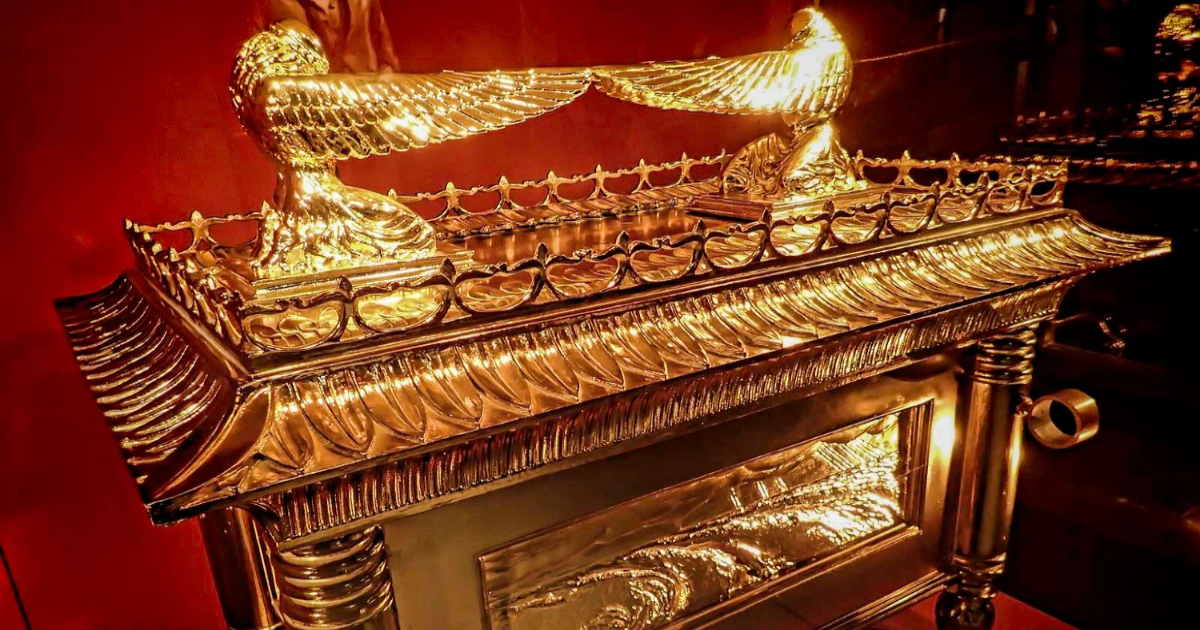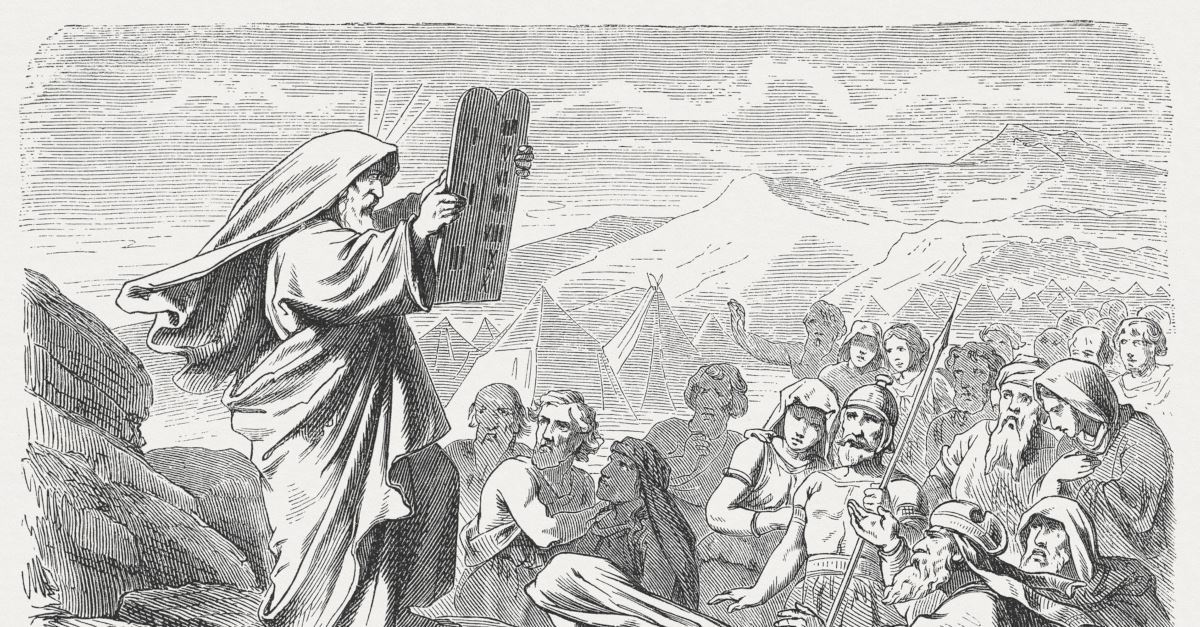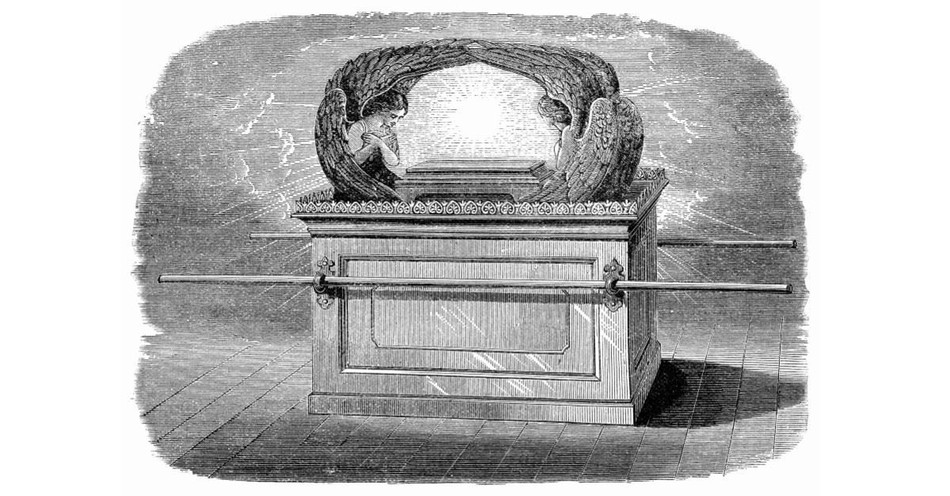The Ark of the Covenant is said to be a gold-covered wooden chest with a decorative golden top called the mercy seat. In the Books of Exodus and 1 Kings in the Bible, it's mentioned that the Ark held the Tablets of the Law which had inscribed the Ten Commandments that God gave to Moses on Mount Sinai.
Ark of the Covenant: Table of Contents
Ark of the Covenant Summary
For a tabernacle was prepared: the first part, in which was the lampstand, the table, and the showbread, which is called the sanctuary; and behind the second veil, the part of the tabernacle which is called the Holiest of All, which had the golden censer and the ark of the covenant overlaid on all sides with gold, in which were the golden pot that had the manna, Aaron's rod that budded, and the tablets of the covenant; and above it were the cherubim of glory overshadowing the mercy seat. Of these things we cannot now speak in detail. (Hebrews 9:2-5)
The Ark of the Covenant was one of the most instrumental symbols of faith and God’s presence. The contents of which included the tables of the Mosaic law, a pot of manna, and the rod of Aaron. The Ark originated from Exodus 25:10 when God commanded Moses to “make an ark of acacia wood.”
God made a covenant with the children of Israel through Moses, which was conditional. He promised good to them and their descendants for generations if they obeyed His laws. However, He always warned of despair, punishment, and dispersion if they disobeyed. As a sign of His promise, God had the Israelites construct the Ark of the Covenant, according to His design, to hold the stone tablets containing the Ten Commandments. This box, called an “ark,” was made of acacia wood overlaid with gold. The Ark was to be kept in the inner sanctum of the Tabernacle in the desert, and later in the Temple in Jerusalem.

Steven Spielberg's artistic rendition of the Ark of the Covenant from the film Indiana Jones and the Raiders of the Lost Ark. Photographed at the "Indiana Jones and the Adventure of Archaeology" exhibit at the National Geographic Museum in Washington D.C., 2015. Original image by Mary Harrsch.
The Ark of the Covenant Bible Verses
In Exodus 25:10-22, the specifics of the Ark were laid out. It needed to be two cubits and a half in length (one cubit is about 19.8-20.6 in.), a cubit and a half in breadth, and a cubit and a half in height. The Ark was overlaid inside and out with pure gold with a molding of gold around it.
For transportation, the Ark had four rings of gold with two rings on each side. A pole of acacia wood overlaid with gold was placed into the rings to carry the ark. These poles for transportation were to be permanent fixtures and never removed.
Constructing the Ark: Exodus 37:1-9
Bezalel made the ark of acacia wood. Two cubits and a half was its length, a cubit and a half its breadth, and a cubit and a half its height. And he overlaid it with pure gold inside and outside, and made a molding of gold around it. And he cast for it four rings of gold for its four feet, two rings on its one side and two rings on its other side. And he made poles of acacia wood and overlaid them with gold and put the poles into the rings on the sides of the ark to carry the ark. And he made a mercy seat of pure gold. Two cubits and a half was its length, and a cubit and a half its breadth. And he made two cherubim of gold. He made them of hammered work on the two ends of the mercy seat, one cherub on the one end, and one cherub on the other end. Of one piece with the mercy seat he made the cherubim on its two ends. The cherubim spread out their wings above, overshadowing the mercy seat with their wings, with their faces one to another; toward the mercy seat were the faces of the cherubim.
The Ark Brought to Jerusalem: 2 Samuel 6:1-4
David again gathered all the chosen men of Israel, thirty thousand. And David arose and went with all the people who were with him from Baale-judah to bring up from there the ark of God, which is called by the name of the Lord of hosts who sits enthroned on the cherubim. And they carried the ark of God on a new cart and brought it out of the house of Abinadab, which was on the hill. And Uzzah and Ahio, the sons of Abinadab, were driving the new cart, with the ark of God, and Ahio went before the ark.
The Earthly Holy Place: Hebrews 9:1-5
Now even the first covenant had regulations for worship and an earthly place of holiness. For a tent was prepared, the first section, in which were the lampstand and the table and the bread of the Presence. It is called the Holy Place. Behind the second curtain was a second section called the Most Holy Place, having the golden altar of incense and the ark of the covenant covered on all sides with gold, in which was a golden urn holding the manna, and Aaron's staff that budded, and the tablets of the covenant. Above it were the cherubim of glory overshadowing the mercy seat. Of these things we cannot now speak in detail.
The Ark of the Covenant Outside the Tabernacle
For the Israelites, the Ark of the Covenant meant God’s presence. Throughout the Old Testament, we see stories of how God provided safety and success using the symbol of the Ark.
In the Book of Joshua, we learn of the safety the Ark provided the Israelites as they passed over the Jordan into the Promised Land. In Joshua 3:6, “Joshua said to the priests, ‘Take up the ark of the covenant and pass before the people.’” When the priests came to the Jordan, just as was commanded, the waters were “completely cut off and the people passed over opposite Jericho” when the Ark neared.
In the sixth chapter of Joshua, the Ark was instrumental in the Battle of Jericho. The Ark was taken around the city six times in six days and was preceded by seven priests who sounded seven trumpets made of rams’ horns (Joshua 6:7). On the seventh day, the Ark with the armed men and priests did the same, but the “people shouted a great shout, and the wall fell down flat” (Joshua 6:20).
The Philistines captured the Ark when Israel summoned possession of the Ark following a brutal defeat. They felt the mere possession of the Ark would give them the favor of God. Israel suffered another defeat and lost the Ark to the Philistines, who were not intimidated by the shouts and the supposed presence of “a god” in the camp (1 Samuel 4:11).
A Cover for the Ark of the Covenant: The Mercy Seat
The Ark required “an atonement cover,” called the Mercy Seat, to be built with pure gold and with the same dimensions in length and breadth as the Ark. There had to be one cherubim of gold on both ends of the Mercy Seat. It was important to have the cherubim spread their wings and face one another, symbolizing the angels’ attention and readiness to do God’s will.
The Mercy Seat was where God would dwell. He said, “There, above the cover between the two cherubim that are over the ark of the covenant law, I will meet with you and give you all my commands for the Israelites” (Exodus 25:22).
Unlike the statutes of gods idolized by many of the Israelites, the Ark of the Covenant served as a religious symbol where the people could meet with God. He hovered over the Ark when the priests were present. If the priests were absent, the presence of the law tablets reflected God’s presence. Thus, the Ark of the Covenant was aptly named because of the commandments written on the tablets.
Contents of the Ark of the Covenant
As God gave instructions on how to build the Ark, he also instructed Moses to put in the tablets of the 10 Commandments (the law). We see later in Numbers 17:10, “The LORD said to Moses, ‘Put back Aaron’s staff in front of the ark of the covenant law, to be kept as a sign to the rebellious.’” And Moses and Aaron already had set aside a jar of manna in it, which the Lord commanded them to put “with the tablets of the covenant law, so that it might be preserved” (Exodus 16:34).
Hebrews 9:4 confirms these three items were inside the Ark of the Covenant: “Behind the second curtain was a room called the Most Holy Place, which had the golden altar of incense and the gold-covered ark of the covenant. This ark contained the gold jar of manna, Aaron’s staff that had budded, and the stone tablets of the covenant.”

Ark of the Covenant Symbolism and Meaning
The Ark and the Tablets
Unlike the statutes of gods idolized by many of the Israelites, the Ark of the Covenant served as a religious symbol where the people could meet with God. He hovered over the Ark when the priests were present. If the priests were absent, the presence of the law tablets reflected God’s presence. Thus, the Ark of the Covenant was aptly named because of the commandments written on the tablets.
The Manna and Aaron’s Rod
The presence of the jar of manna symbolized God’s constant provision for His people. Aaron’s rod was dead, yet grew buds, and was placed inside the ark to symbolize God’s approval as Aaron for High Priest.
The Veil
The Ark of the Covenant was often inside the Tabernacle behind a curtain or veil. This veil separated veil was made of blue, purple and scarlet yarns and hung on “four pillars of acacia overlaid with gold, with hooks of gold, on four bases of silver” (Exodus 26:32). It hung from clasps and served as a separation between of the “Holy Place from the Most Holy Place,” where the Ark of the Covenant and the Mercy Seat, symbolizing God’s presence, were (Exodus 26:33-34).
This veil is also significant in the New Testament. In Mark 15:37-38, we see at the moment Jesus died on the cross, “The curtain of the temple was torn in two from top to bottom.”
Hebrews 10:19-22 explains the significance of this event:
“Therefore, brothers and sisters, since we have confidence to enter the Most Holy Place by the blood of Jesus, by a new and living way opened for us through the curtain, that is, his body, and since we have a great priest over the house of God, let us draw near to God with a sincere heart and with the full assurance that faith brings, having our hearts sprinkled to cleanse us from a guilty conscience and having our bodies washed with pure water.”
Before, Israelites could not enter the Most Holy Place where the Ark of the Covenant, God’s presence, was. Now, all who believe in Christ Jesus can have the confidence to draw near to God.
The Ark of the Covenant Today
Contrary to the Indiana Jones movies, the Ark was not relocated in 1936. The last recorded mention of the Ark of the Covenant’s location in the Bible was in 2 Chronicles 35. King Josiah assigned the priests to their offices and “encouraged them in the service of the house of the Lord” (2 Chronicles 35:2). He then instructed the Levites to “put the holy ark in the house that Solomon the son of David, king of Israel, built. You need not carry it on your shoulders. Now serve the Lord your God and his people Israel” (2 Chronicles 35:3).
The fate of the Ark of the Covenant is a mystery, as its whereabouts are unknown in historical records. The Bible says that the Ark was housed in the Temple of Solomon in Jerusalem for centuries. However, it is not mentioned in the accounts of the Babylonian conquest of Jerusalem in 587 BCE, when the Temple was destroyed. Some theories suggest that the Ark was hidden or taken away before the destruction of the Temple to protect it. Others believe it may have been captured or destroyed.
One popular theory about the whereabouts of the Ark of the Covenant is that it was taken to Ethiopia. According to Ethiopian tradition, the Ark was brought to Ethiopia by Menelik I, the son of the Queen of Sheba. It is said to be kept in the Church of Our Lady Mary of Zion in Axum, Ethiopia. However, the Ark is not shown to the public, and its presence there has not been verified by independent sources.
Despite various claims and theories, the Ark's fate remains one of the great unsolved mysteries of history.
Ark of the Covenant in Revelation
John wrote in Revelation 11:19 that after the Great White Throne Judgment, “God’s temple in heaven was opened, and the ark of his covenant was seen within his temple.” At this time, the veil over the hearts of all Christians, Jews, and Gentiles will be eliminated. This new state of the church will reveal the mysteries of the Word and its truths fully illuminated.
Chad is a believer in Christ, attorney at law, wannabe golfer, runner, dog lover, and writer. He enjoys serving his church as a deacon and Sunday School teacher. You can find him on Facebook, Twitter, and at his golf devotion par3sixteen.com. He and his wife, Brandi, reside in Tennessee with their canine son, Alistair.
Photo Credit: Getty/TonyBaggett



